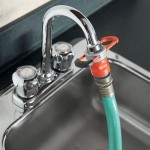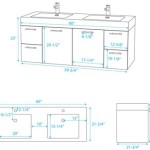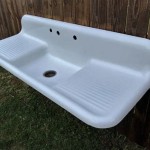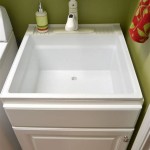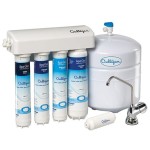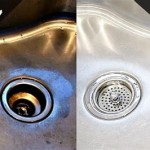Laundry Sink With Cabinet 24 Inch: A Comprehensive Guide
The laundry room, often relegated to a functional space, deserves the same attention to detail as other areas of the home. A well-equipped laundry room enhances not only efficiency but also overall home value and daily convenience. One essential element in a practical laundry room setup is a reliable laundry sink. Specifically, a laundry sink with a cabinet, measuring 24 inches, presents a versatile solution for homes of varying sizes and styles. This article explores the various aspects of a 24-inch laundry sink with a cabinet, covering its features, benefits, selection criteria, installation considerations, and maintenance practices.
A 24-inch laundry sink with a cabinet is designed to provide a dedicated space for tasks exceeding the capabilities of a standard bathroom or kitchen sink. These tasks often include handwashing delicate garments, pre-treating stained clothing, soaking heavily soiled items, and even washing pets. The cabinet component adds valuable storage, keeping laundry essentials such as detergents, fabric softeners, stain removers, and cleaning supplies organized and readily accessible. This combination of functionality and storage makes a 24-inch laundry sink with a cabinet a practical addition to any laundry room.
Key Benefits of a 24-Inch Laundry Sink With Cabinet
A 24-inch laundry sink with a cabinet offers numerous benefits that contribute to a more efficient and organized laundry routine. These benefits extend beyond the basic functionality of a sink and encompass aspects of storage, space utilization, and overall convenience.
Enhanced Functionality: The primary benefit lies in the enhanced functionality it provides. The sink itself offers a dedicated space for laundry-related tasks. The 24-inch size is generally sufficient for handling a variety of items, from delicate blouses to bulky sweaters. Deeper basins are particularly useful for soaking larger items or dealing with significant amounts of water. The presence of a drain allows for easy disposal of water and cleaning solutions, preventing messes and simplifying the laundry process.
Optimized Storage: The integrated cabinet is a crucial element of this setup. It provides enclosed storage space, keeping laundry supplies neatly organized and out of sight. This is particularly important in smaller laundry rooms where space is limited. The cabinet can accommodate various items, preventing clutter and maintaining a cleaner, more organized appearance. Shelves, drawers, and adjustable configurations within the cabinet offer flexibility in storage organization, catering to different needs and preferences.
Space Efficiency: A 24-inch laundry sink with a cabinet is designed with space efficiency in mind. Its compact size makes it suitable for smaller laundry rooms or even multi-purpose rooms where space is a premium. The combination of a sink and storage within a single unit maximizes the use of available space, making it a practical solution for homes with limited square footage. The compact footprint also allows for easier integration into existing laundry room layouts without requiring extensive renovations.
Factors to Consider When Selecting a 24-Inch Laundry Sink With Cabinet
Choosing the right 24-inch laundry sink with a cabinet involves considering several factors to ensure it meets individual needs and complements the existing laundry room setup. Careful consideration of these factors will result in a purchase that provides long-term functionality and satisfaction.
Material and Durability: The material of both the sink and the cabinet is a critical factor. Common sink materials include stainless steel, acrylic, cast iron, and porcelain. Stainless steel is known for its durability, resistance to stains and corrosion, and ease of cleaning. Acrylic sinks are lightweight and offer a variety of color options. Cast iron sinks are durable but require more maintenance due to their potential for chipping. Porcelain sinks are aesthetically pleasing but can be susceptible to damage. The cabinet material also plays a role in durability. Common cabinet materials include wood, laminate, and MDF (medium-density fiberboard). Wood cabinets offer a classic aesthetic but require proper sealing to prevent moisture damage. Laminate cabinets are durable and easy to clean. MDF cabinets are cost-effective but less resistant to moisture than wood or laminate.
Sink Depth and Configuration: The depth of the sink basin is a crucial consideration based on the types of items typically washed in the laundry sink. A deeper basin is ideal for soaking larger items or handling larger volumes of water. Some sinks feature a single basin, while others have double basins for separate washing and rinsing. The configuration should align with the intended uses of the sink. Consider whether a built-in drainboard would be beneficial for drying clothes or other items. The drain placement and size should also be factored in to ensure compatibility with existing plumbing.
Cabinet Design and Features: The cabinet design should complement the overall aesthetic of the laundry room and provide sufficient storage space. Consider the number of shelves, drawers, and compartments needed. Adjustable shelves offer flexibility in organizing items of different sizes. Soft-close hinges and drawer slides add a touch of luxury and prevent slamming. The cabinet door style (e.g., shaker, flat-panel, raised-panel) should align with the overall design of the laundry room. Look for cabinets with water-resistant finishes to protect against moisture damage. Some cabinets feature built-in hamper compartments for added convenience.
Installation and Maintenance Considerations
Proper installation and regular maintenance are essential to ensure the longevity and optimal performance of a 24-inch laundry sink with a cabinet. These aspects are often overlooked but play a significant role in preventing issues and maximizing the lifespan of the unit.
Professional Installation vs. DIY: Installation can be approached as a do-it-yourself (DIY) project or with the assistance of a professional plumber. DIY installation is possible for individuals with basic plumbing knowledge and experience. However, professional installation is recommended, particularly if plumbing modifications are required or if there are concerns about proper sealing and drainage. A professional plumber can ensure that the sink is properly connected to the water supply and drain lines, preventing leaks and other potential problems. Improper installation can lead to water damage, mold growth, and costly repairs.
Plumbing Requirements: Before installation, it's essential to assess the existing plumbing infrastructure and ensure it meets the requirements of the new laundry sink. This includes verifying the availability of hot and cold water supply lines, as well as a properly sized drain line. The drain line should be properly vented to prevent airlocks and ensure efficient drainage. Consider the location of the shut-off valves for the water supply lines, as these may need to be adjusted or replaced. If significant plumbing modifications are required, it's best to consult with a professional plumber to ensure compliance with local building codes.
Cleaning and Maintenance: Regular cleaning and maintenance are crucial for preserving the appearance and functionality of the laundry sink and cabinet. Clean the sink basin regularly with a mild detergent and water to remove soap scum, dirt, and stains. Avoid using abrasive cleaners, as these can scratch the surface. Regularly inspect the drain for clogs and clear any debris that may accumulate. For stainless steel sinks, consider using a stainless steel cleaner to maintain the shine. Wipe down the cabinet surfaces with a damp cloth to remove dust and spills. Inspect the cabinet for signs of water damage, such as swelling or discoloration, and address any issues promptly. Periodically check the plumbing connections for leaks and tighten any loose fittings. Applying a sealant around the edges of the sink can help prevent water from seeping behind the cabinet.
In conclusion, selecting and maintaining a 24-inch laundry sink with a cabinet involves a careful consideration of factors such as material, sink depth, cabinet design, installation requirements, and maintenance practices. By addressing these aspects, homeowners can create a functional and organized laundry space that meets their individual needs and enhances their overall home experience.

Glacier Bay All In One Stainless Steel 24 Laundry Sink With Faucet And Storage Cabinet White 1521us 262 The Home

24 In Kitchen Utility Sink With Cabinet Combo For Laundry Room White

Glacier Bay 24 In W X 10 D 20 L Stainless Steel Laundry Sink With Faucet And Double Door Cabinet Black Ql124kgy The Home

Laundry Utility Sink Cabinet Metro All In One Simpli Home

Style Selections 21 4 In X 24 1 Basin White Freestanding Utility Tub With Faucet 261347

Vingli 24 Inch Laundry Sink With Cabinet Stainless Steel Pull Out Sprayer Faucet White Combo For Room Utility

Laundry Sink Cabinet Modern Wide Shaker All In One Simpli Home

Tileon 24 In X 18 34 Stainless Steel Drop Laundry Sink With Cabinet And Faucet Combo White Aybszhd505

Cabinet 24 Inch Wide Utility Sinks At Com

Darwin 24 Laundry Cabinet With Pull Out Faucet Stainless Steel Sink
